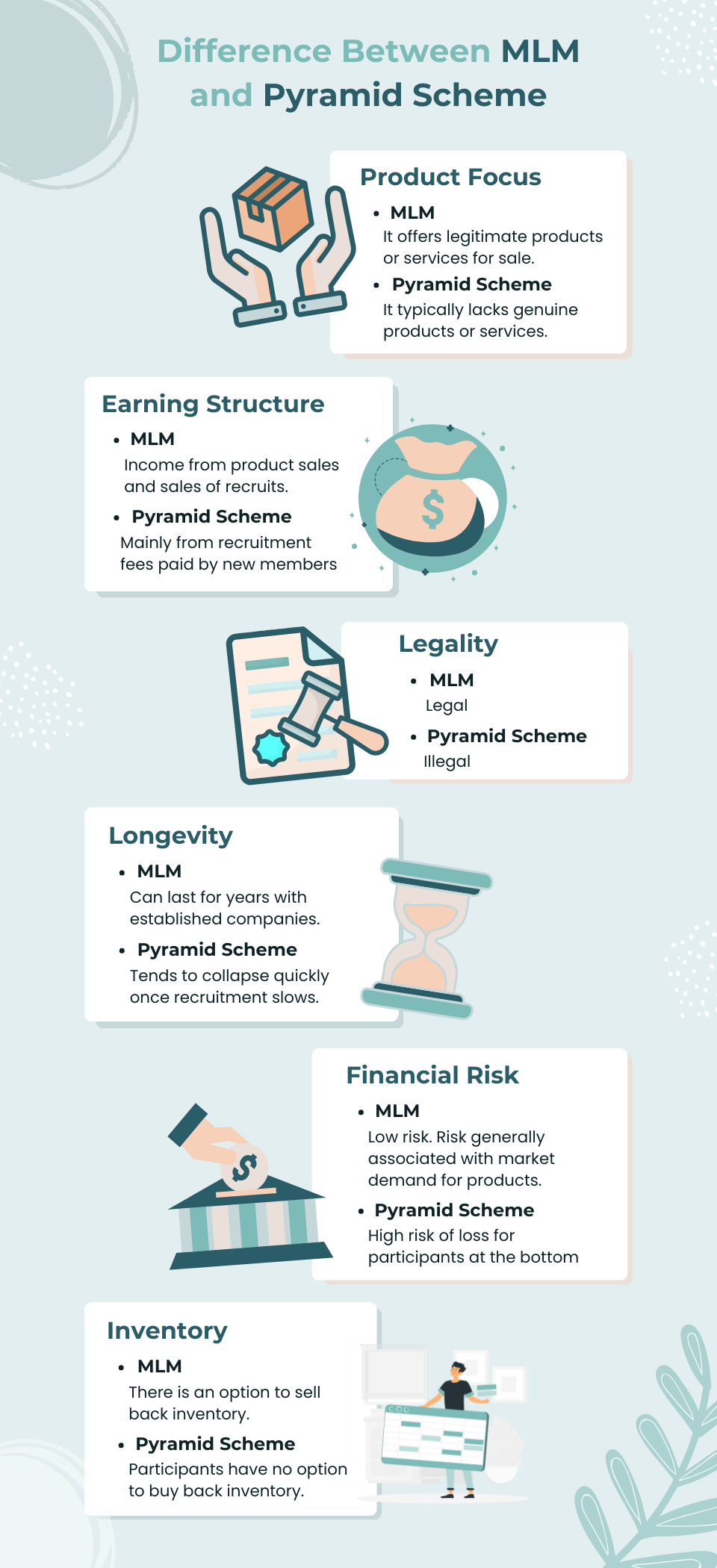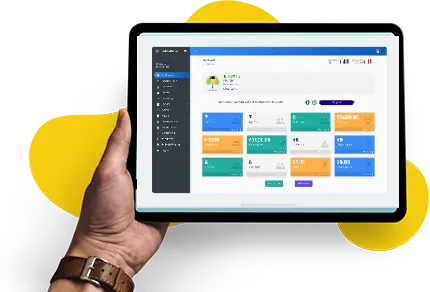We are often asked - What is the Difference Between MLM and Pyramid Scheme? And it is a valid question mainly because the two models share many similarities. There's a fine line between opportunity and exploitation. Two models that often blur this line are Multilevel Marketing (MLM) and Pyramid Schemes.
While both involve recruiting others to earn money, the devil lies in the details, legality, and ethical considerations. In this article, we'll delve into What is the difference between MLM and Pyramid Scheme?
This Article Contains:
Understanding Multilevel Marketing (MLM)
First off, what exactly is MLM? Well, picture a traditional company, right? You've got a product or service, and you're selling it to customers. Simple enough. Now, imagine adding another layer to it - so, instead of just selling a product or service yourself, you also recruit others to sell under you. These recruits can then recruit more people, and so on, creating multiple levels or "downlines."
Now, what makes MLM tick? One key characteristic is the emphasis on recruiting and building a network. It's not just about selling products; it's about building a team and earning commissions not only from your sales but also from the sales of those you recruit.
MLM companies typically have a range of products or services to offer, from health supplements to cosmetics to kitchen gadgets. The idea is that by having a diverse product line, there's something for everyone, which can potentially attract a broader customer base.
Another hallmark of MLM is the tiered commission structure. As you climb the ranks and grow your downline, you can earn higher commissions and bonuses. This incentivizes distributors to not only sell but also to recruit and train others to do the same.
⮚ Examples of Famous MLM Companies
Multi-level marketing (MLM) has seen its share of success stories through various companies. In the table below, we will take a look at some examples of famous MLM companies that have made a mark in the MLM industry.
| Company Name | Year Established | Revenue Estimates |
|---|---|---|
| Amway | 1959 | $7.7 billion |
| Avon | 1886 | $2.77 billion |
| Herbalife | 1980 | $5.1 billion |
| Natura | 1969 | $6.87 billion |
| Vorwerk | 1883 | $4.1 billion |
Also Read: Top 100 MLM Companies in the World for 2024
What is a Pyramid Scheme?
At its core, a pyramid scheme is a business model that promises participants payment or services primarily for enrolling others into the scheme, rather than supplying any real investment or sale of products or services to the public.
Characteristics-wise, pyramid schemes often lack a legitimate product or service. Instead, the focus is on recruiting new members who pay fees to join, and then those fees are distributed up the pyramid to earlier entrants. This creates a situation where the primary way to make money is by recruiting others, rather than by selling actual products or services.
Another red flag is the promise of high returns in a short period with little effort. In legitimate business ventures, success typically requires hard work, time, and sometimes a bit of luck. But in a pyramid scheme, they sell you the dream of getting rich quickly with minimal effort, which is usually too good to be true.
Also, pyramid schemes often collapse under their own weight since they rely on a constant influx of new members to pay off earlier participants. Hence, once recruitment slows down or stops, the whole thing comes crashing down, leaving the majority of participants empty-handed.
So, to sum it up, a pyramid scheme is like a house of cards built on promises of easy money through recruitment, lacking a solid foundation of genuine products or services. It's an illegal and risky business model that's often more about exploiting people's trust and naivety than providing real value.
⮚ Notorious Pyramid Schemes That Ended With Legal Consequences
Pyramid schemes have a notorious history, often promising quick riches but ultimately leaving many investors empty-handed. Here we will provide examples of some of the most infamous pyramid schemes that ended with legal consequences.
1. OneCoin
OneCoin emerged in 2014 as a purported cryptocurrency investment opportunity, promising investors massive returns through its proprietary digital currency. However, unlike legitimate cryptocurrencies such as Bitcoin, OneCoin lacked transparency and failed to provide evidence of blockchain technology backing its currency.
Instead, OneCoin operated as a classic pyramid scheme, relying on recruitment and investments from new members to pay returns to earlier investors. KARL SEBASTIAN GREENWOOD, who co-founded OneCoin was sentenced to 20 years in prison for his orchestration of the massive OneCoin fraud scheme.
2. BurnLounge Inc.
BurnLounge was a pyramid scheme that operated from 2004 to 2007. It primarily sold digital music and encouraged participants to recruit others into the scheme. However, the Federal Trade Commission (FTC) found BurnLounge to be an illegal pyramid scheme, and in 2012, the company settled with the FTC, agreeing to pay $17 million in restitution.
3. TelexFree
TelexFree was a multilevel marketing scheme that operated from 2012 to 2014, primarily targeting Brazilian immigrants in the United States. Promising high returns for minimal effort, TelexFree purported to offer internet phone services but primarily relied on recruitment fees for revenue.
Participants were encouraged to invest in TelexFree's AdCentral packages and recruit others to do the same. However, investigations by U.S. and Brazilian authorities revealed that TelexFree was a pyramid scheme, defrauding hundreds of investors for millions of dollars.
Difference Between an MLM and a Pyramid Scheme
As we mentioned earlier, two models that often get mixed up are pyramid schemes and multilevel marketing (MLM). While they both involve recruiting others, the core distinctions lie in their focus, legality, and earning structures. In the table below, we have broken down the main differences to make things clearer:
| Criteria | MLM | Pyramid Scheme |
|---|---|---|
| Product Focus | It offers legitimate products or services for sale. | It typically lacks genuine products or services. |
| Earning Structure | Income from product sales and sales of recruits. | Mainly from recruitment fees paid by new members. |
| Legality | Legal | Illegal |
| Longevity | Can last for years with established companies. | Tends to collapse quickly once recruitment slows. |
| Financial Risk | Low risk. Risk generally associated with market demand for products. | High risk of loss for participants at the bottom. |
| Inventory | There is an option to sell back inventory. | Participants have no option to buy back inventory. |

How to Properly Evaluate Whether the Business is an MLM or a Pyramid Scheme?
Here are some main ways how you can properly evaluate whether a business opportunity is an MLM or a Pyramid Scheme:
1. Research the Company
Start by learning more about the company's history and reputation. Search the company's name along with terms like "review," "scam," or "complaint" on the internet. Dig beyond the first page of search results to get a comprehensive view. Look for articles in newspapers, magazines, or online sources.
Find out:
How many years has the company been operational?
Is the company known for providing good customer satisfaction?
What are people saying about the company and its products on blogs and websites?
Has the company been involved in lawsuits for deceptive practices?
2. Check with the State Attorney General
Consult your state's Attorney General's office for any complaints against the company. While the absence of complaints doesn't guarantee legitimacy, a pattern of complaints can be a warning sign.
3. Opportunity Meetings and Pressure
Avoid making hasty decisions at "opportunity meetings" where you may feel pressured to sign up or invest. Take your time to evaluate the opportunity without pressure.
4. Review Terms and Conditions
Ask your sponsor or the company for the terms and conditions of the business plan. This should include:
-
Compensation structure: Understand how you earn money, including commissions and bonuses.
-
Potential expenses: Be aware of any costs associated with joining and maintaining your business.
-
Support for income claims: Ask for evidence to support claims about potential earnings.
-
Contact information: Have the name and contact details of a company representative who can address your questions and concerns.
5. Assess Your Income Source
Consider where your income is expected to come from. In an MLM, your income should primarily come from product sales, both your own and those of your recruits. In a Pyramid Scheme, income is mainly derived from recruiting new members and their joining fees.
6. Inventory Requirements
Be cautious if you're required to buy a significant amount of inventory upfront. In legitimate MLMs, inventory purchases are usually optional and based on demand.
7. Unwanted Purchases
If you're pressured to buy products you don't want or you need just to maintain your status with the company, it could be a red flag.
8. Rags-to-Riches Stories
Be wary of claims of extraordinary wealth or lavish lifestyles resulting from participation in the program. Such stories are often used to lure individuals into Pyramid Schemes.
9. Product Value and Demand
Evaluate the products being offered. Ask yourself these questions:
Are they genuine, with real value?
Are they reasonably priced?
Are these products that consumers would want to buy repeatedly?
Potential Red Flags to Watch Out for
To spot potential pyramid schemes, watch out for these warning signs:
Being asked to recruit new members to make money.
Offers goods or services with little or doubtful value that only serve to promote the scheme.
High upfront costs for large quantities of goods.
Lack of actual goods or services being offered for sale.
Promises of guaranteed income or winnings.
By following these steps and being aware of red flags, you can properly assess whether a business opportunity is a legitimate MLM or a potentially deceptive Pyramid Scheme. It's essential to do your due diligence and not rush into any decision that involves your time and money.
Conclusion
So, as we wrap up this exploration on "What is the difference between MLM and Pyramid Scheme?", it's crucial to keep in mind the key takeaway - while MLMs offer authentic products or services and a chance to earn through genuine sales and team building, pyramid schemes focus on recruitment without a tangible product. This makes MLMs legal and pyramid schemes illegal.
If you are ready to take your multilevel marketing business to the next level, consider using the Global MLM Software. We're here to supercharge your business growth. With our integrated platform and over 200 features, we've got everything you need to build a thriving MLM empire.
FAQs
1. Why is that pyramid schemes are deemed illegal while MLM are deemed legal?
Pyramid schemes are illegal because they focus on recruitment over product sales, promising participants payments for recruiting others into the scheme. MLM (Multi-Level Marketing), on the other hand, involves selling products or services and also earning from the sales of those you recruit. The key difference is MLM's emphasis is on product sales, which makes it a legitimate business model.
2. Why is Avon not a pyramid scheme?
Avon is not a pyramid scheme because it primarily earns revenue from selling products (skincare, personal care, etc.), not from recruitment. In Avon, representatives earn commissions from the products they sell directly to customers, as well as from the sales made by representatives they recruit. The focus is on product sales, distinguishing it from illegal pyramid schemes.
3. What is the most famous pyramid scheme?
Besides the three pyramid schemes, we already mentioned in this article, one of the most famous pyramid schemes is the "Bernie Madoff Ponzi Scheme." Bernie Madoff's scheme was uncovered in 2008 and is one of the largest and most notorious in history, defrauding thousands of investors for billions of dollars. Bernard Madoff was sentenced to 150 years in federal prison.







Comments
Leave a Reply
Your email address will not be published. Required fields are marked *